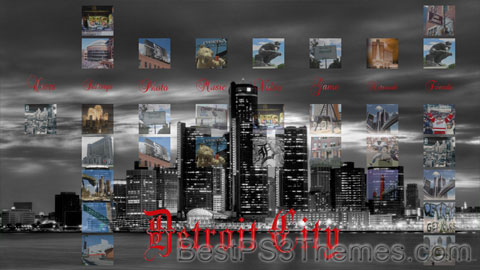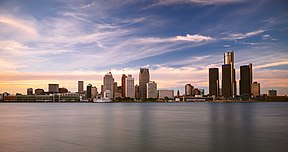Detroit theme by Ghetto Ass Productions
Download: Detroit.p3t

(1 background)
Detroit | |
|---|---|
|
| |
| Etymology: French: détroit (strait) | |
| Nicknames: The Motor City, Motown, The D, 313, D-Town, Renaissance City, The Town That Put The World on Wheels, Hockeytown, Detroit Rock City | |
| Motto(s): Speramus Meliora; Resurget Cineribus (Latin: We Hope For Better Things; It Shall Rise From the Ashes) | |
| Coordinates: 42°19′53″N 83°02′45″W / 42.33139°N 83.04583°W[1] | |
| Country | |
| State | |
| County | Wayne |
| Founded | July 24, 1701 |
| Incorporated | September 13, 1806 |
| Founded by | Antoine de la Mothe Cadillac & Alphonse de Tonty |
| Named for | Detroit River |
| Government | |
| • Type | Strong Mayor |
| • Body | Detroit City Council |
| • Mayor | Mike Duggan (D) |
| • Clerk | Janice Winfrey |
| • City council | Members
|
| Area | |
| • City | 142.89 sq mi (370.09 km2) |
| • Land | 138.73 sq mi (359.31 km2) |
| • Water | 4.16 sq mi (10.78 km2) |
| • Urban | 1,284.8 sq mi (3,327.7 km2) |
| • Metro | 3,888.4 sq mi (10,071 km2) |
| Elevation | 656 ft (200 m) |
| Population | |
| • City | 639,111 |
| • Estimate (2023)[4] | 633,218 |
| • Rank | 63rd in North America 27th in the United States 1st in Michigan |
| • Density | 4,606.84/sq mi (1,778.71/km2) |
| • Urban | 3,776,890 (US: 12th) |
| • Urban density | 2,939.6/sq mi (1,135.0/km2) |
| • Metro | 4,365,205 (US: 14th) |
| Demonym | Detroiter |
| GDP | |
| • MSA | $305.412 billion (2022) |
| Time zone | UTC−5 (EST) |
| • Summer (DST) | UTC−4 (EDT) |
| ZIP Codes | 482XX |
| Area code | 313 |
| FIPS code | 26-22000 |
| GNIS feature ID | 1617959[1] |
| Major airports | Detroit Metropolitan Airport, Coleman A. Young International Airport |
| Mass transit | Detroit Department of Transportation, Detroit People Mover, QLine |
| Website | detroitmi |
Detroit (/dɪˈtrɔɪt/, dih-TROYT; locally also /ˈdiːtrɔɪt/, DEE-troyt)[8] is the most populous city in the U.S. state of Michigan. It is the largest U.S. city on the United States–Canada border, and the seat of government of Wayne County. Detroit had a population of 639,111 at the 2020 census,[9] making it the 29th-most populous city in the United States. Detroit experienced a dramatic decline in population from a peak of 1,849,568 in 1950, losing two-thirds of its population (65.4%) by 2020. The Metro Detroit area, home to 4.3 million people, is the second-largest in the Midwest after the Chicago metropolitan area and the 14th-largest in the United States. A significant cultural center, Detroit is known for its contributions to music, art, architecture, and design, in addition to its historical automotive background.[10][11]
In 1701, Antoine de la Mothe Cadillac and Alphonse de Tonty founded Fort Pontchartrain du Détroit. During the late 19th and early 20th century, it became an important industrial hub at the center of the Great Lakes region. The city's population rose to be the fourth-largest in the nation by 1920, after New York City, Chicago, and Philadelphia, with the expansion of the automotive industry in the early 20th century.[12] The Detroit River became the busiest commercial hub in the world as it carried over 65 million tons of shipping commerce each year. In the mid-20th century, Detroit entered a state of urban decay which has continued to the present, as a result of industrial restructuring, the loss of jobs in the auto industry, and rapid suburbanization. Since reaching a peak of 1.85 million at the 1950 census, Detroit's population has declined by more than 65 percent.[9] In 2013, Detroit became the largest U.S. city to file for bankruptcy, which it successfully exited in December 2014.[13]
Detroit is a port on the Detroit River, one of the four major straits that connect the Great Lakes system to the St. Lawrence Seaway. The city anchors the second-largest regional economy in the Midwest and the 14th-largest in the United States.[14] Detroit is best known as the center of the U.S. automotive industry, and the "Big Three" auto manufacturers—General Motors, Ford, and Stellantis North America (Chrysler)—are all headquartered in Metro Detroit.[15] The Detroit Metropolitan Airport is among the most important hub airports in the United States. Detroit and its neighboring Canadian city Windsor constitute the second-busiest international crossing in North America, after San Diego–Tijuana.[16]
Detroit's diverse culture has had both local and international influence, particularly in music, with the city giving rise to the genres of Motown and techno and playing an important role in the development of jazz, hip-hop, rock, and punk. The rapid growth of Detroit in its boom years resulted in a globally unique stock of architectural monuments and historic places. Since the 2000s, conservation efforts have managed to save many architectural pieces and achieve several large-scale revitalizations, including the restoration of several historic theaters and entertainment venues, high-rise renovations, new sports stadiums, and a riverfront revitalization project.
An increasingly popular tourist destination, Detroit receives 16 million visitors per year.[17] In 2015, Detroit was named a "City of Design" by UNESCO, the first U.S. city to receive that designation.[18]
History[edit]
Toponymy[edit]

Detroit is named after the Detroit River, connecting Lake Huron with Lake Erie. The name comes from the French word détroit meaning 'strait' as the city was situated on a narrow passage of water linking the two lakes. The river was known as le détroit du Lac Érié in French, which means 'the strait of Lake Erie'.[19][20] In the historical context, the strait included the St. Clair River, Lake St. Clair, and the Detroit River.[21][22]
Early settlement[edit]
Kingdom of France 1701–1760
Kingdom of Great Britain 1760–1783
United States 1783-1812
United Kingdom 1812–1813
United States 1813–present
Paleo-Indians inhabited areas near Detroit as early as 11,000 years ago including the culture referred to as the Mound Builders.[23] By the 17th century, the region was inhabited by Huron, Odawa, Potawatomi, and Iroquois peoples.[24] The area is known by the Anishinaabe people as Waawiiyaataanong, translating to 'where the water curves around'.[25]
The first Europeans did not penetrate into the region and reach the straits of Detroit until French missionaries and traders worked their way around the Iroquois League, with whom they were at war in the 1630s.[26] The Huron and Neutral people held the north side of Lake Erie until the 1650s, when the Iroquois pushed them and the Erie people away from the lake and its beaver-rich feeder streams in the Beaver Wars of 1649–1655.[26] By the 1670s, the war-weakened Iroquois laid claim to as far south as the















